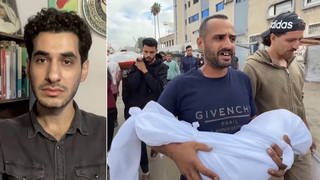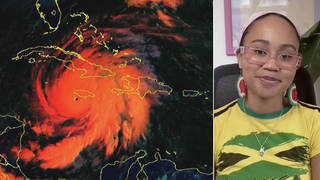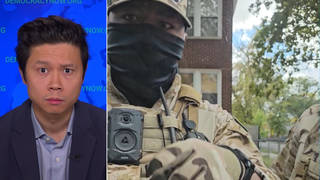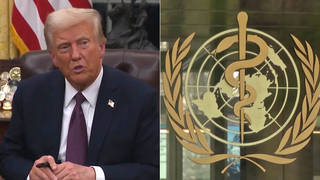
Topics
Guests
- Martin Kulldorffprofessor of medicine at Harvard University, a biostatistician and epidemiologist.
- Abraar Karaninternal medicine doctor at the Brigham and Women’s Hospital and at Harvard Medical School.
As coronavirus cases increase across much of the United States, the Trump administration has reportedly adopted a policy of deliberately letting the virus infect much of the U.S. population in order to attain “herd immunity” — despite warnings from the World Health Organization against such an approach. We host a debate on the contentious issue of herd immunity and how best to confront the virus with two Harvard medical experts: epidemiologist Martin Kulldorff, a professor of medicine at Harvard University and one of the lead signatories of the controversial Great Barrington Declaration arguing for an easing of lockdowns, and Dr. Abraar Karan, an internal medicine doctor at the Brigham and Women’s Hospital and at Harvard Medical School who has worked on the COVID-19 public health response in Massachusetts since February.
Transcript
AMY GOODMAN: The United States reported nearly 60,000 new coronavirus cases on Wednesday, the highest daily toll since August. About 1,000 U.S. residents died of COVID-19 Wednesday, bringing the death toll since March to nearly 217,000, the highest death toll in the world.
This comes as The Washington Post and The New York Times report that Trump administration officials say they have adopted a policy of deliberately letting the virus infect much of the U.S. population in order to attain herd immunity. Health experts warn the strategy might not even be possible and could lead to more than 2 million U.S. deaths. In Geneva, Switzerland, the head of the World Health Organization, Dr. Tedros Adhanom Ghebreyesus, said Monday herd immunity should only be reached through vaccination, not natural infection.
TEDROS ADHANOM GHEBREYESUS: Herd immunity is achieved by protecting people from a virus, not by exposing them to it. Never in the history of public health has herd immunity been used as a strategy for responding to an outbreak, let alone a pandemic. It’s scientifically and ethically problematic. … In most countries, less than 10% of the population have been infected with the COVID-19 virus. Letting the virus circulate unchecked therefore means allowing unnecessary infections, suffering and death.
AMY GOODMAN: While the World Health Organization is warning nations not to adopt a herd immunity strategy, some epidemiologists and doctors have embraced it. A group of three professors and doctors who teach at Harvard, Stanford and Oxford recently co-authored an open letter in defense of herd immunity. It’s known as the Great Barrington Declaration.
The letter begins, quote, “As infectious disease epidemiologists and public health scientists we have grave concerns about the damaging physical and mental health impacts of the prevailing COVID-19 policies, and recommend an approach we call Focused Protection.”
The letter goes on to state, quote, “Those who are not vulnerable should immediately be allowed to resume life as normal.”
The Great Barrington Declaration is named after a town in western Massachusetts which is home to the American Institute for Economic Research, a Koch brother-funded think tank that sponsored the open letter.
Many other public health experts have expressed alarm over this call to embrace herd immunity. On Wednesday, a group of doctors and scientists signed an open letter in The Lancet medical journal, stating, quote, “The evidence is very clear: controlling community spread of COVID-19 is the best way to protect our societies and economies until safe and effective vaccines and therapeutics arrive within the coming months.” The open letter is being called the John Snow Memorandum, named after the founder of modern epidemiology.
Today we host a debate on this contentious issue. Joining us from Ashford, Connecticut, is Martin Kulldorff, a professor of medicine at Harvard University, one of the three lead signers of the Great Barrington Declaration. He’s a biostatistician, epidemiologist, with expertise in detecting and monitoring infectious disease outbreaks and vaccine safety evaluations. Joining us from Boston is Dr. Abraar Karan, an internal medicine doctor at Brigham and Women’s Hospital and Harvard Medical School. He has worked on the COVID-19 public health response in Massachusetts since February, as well as directly cared for COVID-19 patients.
We welcome you both to Democracy Now! Dr. Kulldorff, you have signed this very controversial letter, what’s being called the Great Barrington Declaration. Can you explain what it is and why you support what’s called herd immunity?
MARTIN KULLDORFF: Thank you so much, Amy, for having me on the show.
The lockdown and the response that we have done in the world towards the pandemic is the worst assault on the working class in half a century. One feature of COVID-19 is that while anybody can be infected, there’s a huge difference in risk by age. And it’s not just twofold or fivefold or tenfold. It’s not even hundredfold. There is a more than a thousandfold difference in risk by age for mortality of COVID-19.
So, what we’re doing now with the current strategy that’s been in place since the beginning of the year is we are protecting lower-risk college students and lower-risk professionals, like bankers, scientists like me, journalists like you, while putting the burden on the working class, who are forced to work, as a bus driver, a janitor, or working in the supermarket, even if they’re old. So we are protecting lower-risk, privileged professionals while putting the burden on the working class, including high-risk working-class people who have to work, to build the immunity that eventually will protect everybody in the community.
AMY GOODMAN: Dr. Abraar Karan, you’ve been tweeting away and, certainly, to say the least, discussing the Great Barrington Declaration, but, more importantly, broader than that, have definitely criticized herd immunity. Talk about your major concerns and what you think needs to be done.
DR. ABRAAR KARAN: Absolutely. Thanks so much for having me.
And, you know, I’ll start by saying that there is a bit of a false dichotomy when we talk about the options being either these extreme lockdowns versus just letting the virus rip and having herd immunity. In fact, if we think back to when we initially locked down, the strategy for doing that was actually to slow down transmission of cases so that they didn’t overwhelm our healthcare systems, and also to build up an actual epidemic response, whereby we could actually have strong surveillance over where new outbreaks were occurring, where we could actually still test, trace, isolate new cases as they were occurring. And so, I think the way that this is being framed is problematic, because neither, to me, are actually strategies.
On the one hand, lockdowns are actually emergency backstops to stop transmission when it gets completely out of hand. And we saw that happen here in the United States, and we saw other countries that actually dealt with this quickly and actually used tests, tracing and isolating and masking from the start, so that they never had enormous outbreaks that they could no longer control.
Now, on the other hand, you’ve got this herd immunity, which, you know, typically, as you’ve heard the WHO director-general say, we’re talking about this in terms of vaccinating people, not just exposing them to the disease, but actually giving them a vaccine that is not going to make them sick or make them need to be hospitalized or suffer further consequences from this.
So, in terms of my particular critiques, you know, I take care of patients. I’ve seen so many COVID patients since the start of the epidemic. Now, if somebody were to tell me that we were going to have an age-based protection, whereby you just are isolating people who are older and letting other people run free and get infected, I’ll tell you this: Many of my most vulnerable patients live in crowded households that are intergenerational households, and they are the support systems for older people. So, when you have an visible spread of a virus like this, inevitably it will go from the first layer of younger people, who may not get as sick, and it will make its way to people who will get more sick. And those are the people that we are seeing in the hospital.
And, you know, beyond that, I would say this: When we overly focus on who is dying from this, we are ignoring the fact that this is a novel respiratory pathogen. Even in younger people, even in middle-aged people, we are seeing longer-term comorbidities and morbidity effects, such as long COVID neurologic effects. You know, just recently, this week, I’ve seen patients with this. So, I think that aspect is also not being taken into account.
And beyond that, if you’re talking about a herd immunity where you’re letting 60% or so of this population get infected, you’re talking about 60% of 330 million people in this country. That is going to overwhelm our healthcare system absolutely. And it’s going to make everything much worse than it was even earlier on.
NERMEEN SHAIKH: Dr. Kulldorff, I’d like you to respond to what Dr. Karan said and also to some of the criticisms that have been made of the Barrington Declaration, including by very prominent figures. Francis Collins, the National Institutes of Health director, called the declaration “fringe” and “dangerous.” It’s also — the declaration has also been faulted for not citing any data. And another prominent epidemiologist, Gregg Gonsalves, has said that the forced protection strategy you advocate is not a plan, but a massacre.
And then, also, Dr. Karan just pointed out that the key issue, or the only issue, should not be mortality rates, which is what the declaration focuses on, given the number of instances that we’ve seen among younger populations of morbidities that are long-lasting, including possibly permanent damage to the heart and lungs, the so-called long COVID. Why is it that the declaration only looks at mortality rates, and not, possibly — certainly, long-term effects of the virus, and possibly even permanent ones among younger populations?
MARTIN KULLDORFF: So, in combination, the three of you, I think that was about 20 things to respond to. And so I will just say that you can watch [inaudible] that goes with the declaration for detail those things. I will also like to say that when Amy characterized this declaration, there was a number of errors that she made, and maybe in a different program tomorrow she can correct those mistakes.
I would say that one thing that is wrong is to have a debate about herd immunity is nonsensical. That’s like having a debate among physicists about gravity. Herd immunity is a scientifically established phenomena that just exists. So, to have — and every strategy that we use will eventually lead to herd immunity. So, for us to discuss whether we should reach herd immunity, that’s like having two pilots in an airplane discussing whether they should use gravity as a strategy to get the airplane down on the ground. The airplane will eventually get down on the ground, no matter what. The key thing is to minimize mortality. So we want to minimize mortality until this pandemic is over.
So, and of the 20 things that you asked me about, maybe you should define one of them, and I will respond to that one.
NERMEEN SHAIKH: Well, firstly, why is it — you’ve just talked about mortality rates again. Why is it that you’re only looking at mortality rates and not long-term morbidities, like possibly permanent damage to the lungs and heart among younger people and this phenomenon of long COVID, of which there have been many reports?
MARTIN KULLDORFF: So, first of all, in terms of long-term effects, we don’t know anything about the long-term effects beyond one year, for obvious reasons, because it hasn’t been around for that long. In terms of long — sort of six-month effects, that’s a common thing for many infectious diseases, including the annual influenza. There has been no reports that I have seen that shows that the long-term effects of COVID-19 is any more common than the long-term effects of the influenza.
AMY GOODMAN: Dr. Kulldorff, you said that I misspoke at the beginning. Why don’t you correct what you think I said wrong?
MARTIN KULLDORFF: Well, one thing is the debate about herd immunity. And another one thing is that the declaration is not arguing that anybody should go out and get infected. Just like if you have with car traffic, you let people drive a car. That doesn’t mean that you let them go and get killed in a car accident, even though some will, and we know that some will.
So, we will let young people and children go to school, for example, or go to university, for in-person teaching. That’s extremely important for these children and for the students, not just for their education, but also for their physical health and their mental health, which is a major concern, this collateral damage. So, we are not letting people get infected. That’s nonsense. And nobody should go deliberately become infected. But young people, who are at very minimal risk — for children, the risk for COVID is less than the annual influenza, which typically kills between 200 and a thousand children every year. So the risk to them is very, very low. And when we let them live their — we need to let them live their lives, to get their education, to have proper physical health and mental health.
But that doesn’t mean that we’re trying to pursue a herd immunity strategy or try to get people to get infected. So, that’s a very, very serious and major mischaracterization of this declaration, and I think it’s very serious that people are making those, because we need to have an open debate about these things.
And it’s not just the three of us who authored this who have signed this declaration, who I think comes from reasonable, respectable universities. We also have, for example, the former chair of the Department of Epidemiology at Harvard School of Public School who has signed this declaration. So, very prominent people, very prominent scientists have signed this, and so on. So, this is not a fringe opinion at all.
Also, if you go back a year only, what we are proposing is just the same thing as every country in Europe had in their pandemic response plans, because we knew there was going to be a pandemic at some point, and there will be more after this one. So, what we are proposing is basic public health principles that was in every one of these pandemic plans in Europe, that were thrown out of the wind at the beginning of this year, instead doing this very tragic experiment with lockdowns.
And it was right to flatten the curve, to not overwhelm the hospitals. That was a correct strategy, that everybody agrees with. But then to try to suppress and eliminate a disease that cannot be eliminated, that cannot be eradicated, is very misguided, and it leads to — or it has in the United States —leads to much higher mortality than there should have been if we had done a focused protection strategy instead.
NERMEEN SHAIKH: Dr. Karan, I’d like you to respond to what Dr. Kulldorff has said, what he said earlier about the disproportionate impact of this, of the lockdowns and the policies that have been pursued, on the working class, and protecting the relatively privileged while compromising the well-being of the working class, who have been forced to work even through these lockdowns.
And in particular, you’ve worked in Asia, as well as in Latin America and in Africa. The effects there, of course, have been far more devastating than here or in Europe, with several recent reports warning of hundreds of millions of people being pushed into poverty, potentially, as Oxfam reported, up to 12,000 people starving a day, a widespread crisis in education for hundreds of millions of children, who, potentially, because they don’t have access to home education, could induce a generational crisis in education in many of these countries. How is it that these impacts can be reduced on vulnerable populations all across the world by doing something other than lockdowns in countries that are resource-poor and can’t necessarily afford alternative strategies?
DR. ABRAAR KARAN: Absolutely. So, the focus for so many of us has been around the fact that the strategies have left behind some of the most poor and vulnerable people in our society. And this is not a surprise. This has happened before the pandemic. We have so much inequity. And the focus of the response has to be on protecting the most vulnerable. So, if you think back to our response in the United States, in May, once we realized there was a disproportionate impact on people of color, who were frontline workers, who lived in crowded housing, who were not able to stay home while the rest of us were able to, what we should have done is protect these populations, making sure that they have access to the PPE that they need, access to paid leave, access to safer working conditions. Nobody is arguing with that at all.
And, you know, when we characterize certain countries — as you mentioned, I’ve worked in sub-Saharan Africa. Actually, I’ll tell you, a lot of those countries are sort of mischaracterized, in the sense that there’s an assumption that they won’t be able to handle pandemics or respond to pandemics. Actually, some of these countries are true experts, well beyond what we are in the United States, in terms of how to utilize the fundamentals of epidemic response, such as testing, tracing, isolating, wearing masks.
So, you know, I had a colleague who was in Rwanda earlier this year. He said when he landed in the airport, they checked his symptoms. They had exactly the seat that he sat in on the plane, exactly where he would be staying. They checked his temperature. And they made sure that they were going to follow out any sort of cases that happened, so that they could trace and isolate people. And he said, on the other hand, when he came back to the United States, he walked right in. Nobody asked a single question. And there he went.
You know, I wanted to address something that Dr. Kulldorff had said, which was that it’s silly to not talk about herd immunity. Well, actually, nobody is saying that we aren’t talking about herd immunity. We’re talking about herd immunity with a vaccine. We have been pushing forward to get a vaccine. And I know that Dr. Kulldorff himself on other podcasts has mentioned that a vaccine is an important part of any strategy to control the epidemic. Right? It’s not going to be a silver bullet, and we’re not going to likely eliminate COVID. But we need to get it to extremely low levels. And so many countries have proven that there’s ways to do this when you stick to the fundamentals of epidemic response.
And so, why is it that in our country we are pushing towards making an excuse to not do that work and instead use a theoretical strategy, which I think, pragmatically, just won’t work, based on all of the patients I’ve talked to? For us, this is the real deal. I’ve talked to people who have been infected with COVID, who infected family members in their home because of the conditions that they lived in, and they were killed by inequity, and they were killed by an incompetence of the response.
AMY GOODMAN: So, let’s talk about that incompetence of the response. Dr. Kulldorff, I was wondering if you could describe your White House meeting, the meeting you had with Alex Azar, the head of Health and Human Services, when you went to lay out the herd immunity — your herd immunity push. And this is what I wanted to ask. You have laid this out as lockdown — which we all agree has horrific effects, from massive joblessness, tens of millions of people out of work, the psychological effects of all of this, poverty, to name a few — to let it rip, so you don’t have a lockdown, just let it go through, because those effects are less bad, you say. Did you argue to Azar for him to argue to the president that talking about the response of the U.S., the lack of tests, the lack of masks, that, first and foremost, to protect everyone, would be, as — we often look at Europe. Why look at Europe? What about Asia? What about Taiwan, Singapore, China, Laos, Vietnam, how they have contained this virus with the same public health measures that are supported by the vast majority of public health professionals?
MARTIN KULLDORFF: So, you’re again doing a mischaracterization by claiming that this is a push for herd immunity or to let things rip through society. That’s the very opposite of the Great Barrington Declaration.
AMY GOODMAN: So, explain.
MARTIN KULLDORFF: There is basically three major strategies one can use. One can do nothing. And that’s very, very bad, because if we do nothing, then we’re going to have some old and some young people get infected, and with old people infected, some of them are going to die, and we’re going to have high mortality.
If we do a strategy that protects everybody equally, irrespective of age, we are pushing the pandemic forward in time, but eventually people are still going to be infected. And there will be some old and some young people getting infected, and since a fair amount of old people are infected, we will have high mortality.
On the other hand, if we do a focused protection, which is what the Great Barrington Declaration proposes, by focusing protection on the high-risk elderly, instead of the privileged members of society, some of which are old and some of which are young — so, if we focus the protection of the high-risk elderly and other high-risk group, while letting young people live their lives, then we will have fewer older people getting infected, but we will have more younger people getting infected. We will also shorten the time of the pandemic, so that older people — will make it easier for older people to protect themselves, because they’ll only have to self-isolate for a number of months instead of what now is going to be more than a year. So, that will help them protect. And if we do that, then we will have lower mortality, because there will be fewer of the old people who get infected.
NERMEEN SHAIKH: Dr. Kulldorff, could you talk specifically, because, of course, the declaration advocates opening schools — what do we know about the infection rates of children and the likelihood that children, if they go to schools, could come home and infect their parents? And the second question is: What do we know about the percentage of people who have an infection who develop serious symptoms, not necessarily die from the infection, but develop serious infections, versus those who remain either asymptomatic or develop light symptoms?
MARTIN KULLDORFF: The second question, most young people are asymptomatic or mildly symptomatic only. Old people, this is a major danger to them, especially for mortality.
What we know about children, we actually know a lot about children. And if we think like scientists, we have to see what happens if schools are open during the pandemic. And there’s only one country in the Western world, major country, who kept schools open during the height of the pandemic during the spring, and that was Sweden. So, if we want to answer that question, we have to look at Sweden.
So, Sweden kept childcare and schools open from ages 1 to 15 throughout the pandemic, when there was a lot of transmission in society. There were 1.8 million children in this age group. And during the spring and early summer, there were exactly zero children who died from COVID-19 among this 1.8 million. There were half of — a handful, I think half a dozen or so, ICU and some hospitalizations. But for children, this is a very — this is not a dangerous thing compared to, for example, the annual influenza, that kills much more children every year.
They also looked at the teachers, because maybe the children will infect the teachers. And they found that teachers had the same risk of COVID as the average of other professions. And since some other professionals worked at home, it actually had lower risk than those other professions who were actually on site. So, that shows that the risk of children infecting adults is very small. And that has also been shown through genetic studies from Iceland, where they looked at the genetics of the virus to see how it spread, whether — you can see if it spread from the parent to the child or from the child to the parents. And most transmission was from the parent to the child. So, there’s no —
AMY GOODMAN: We’re going to break and then come back to —
MARTIN KULLDORFF: There’s no public health reason to keep schools closed. They should all be open for in-person teaching. And same with universities. If children are sick, stay at home. And older teachers, if they are in their sixties, they are high risk, so there should be ways to let them work from home, either by doing online teaching or by helping other teachers, creating exams or homework or essays and stuff like that.
AMY GOODMAN: Dr. Kulldorff, I wanted to ask you about a report from Sky News and The Hill. You have “White House officials [promote] herd immunity declaration signed by fake names.” This is the Great Barrington Declaration. Report found last week — Sky News found dozens of fake names had signed the document, including Dr. I.P. Freely, Dr. Person Fakename, Dr. Johnny Bananas. Another signatory called himself Dr. Harold Shipman, a general practitioner in United Kingdom. In 1998, a man named Harold Shipman was arrested after killing more that 200 of his patients. What can you say about this?
MARTIN KULLDORFF: So, I’m a simple scientist. I actually have a question for you, because we have half a million people who have signed this, including thousands of very prominent medical and public health scientists. We also put up — we also sort of show that, for sort of the fun of it, that somebody named Johnny Bananas had done that, clearly being a fake name, which we are removing. So, why are you asking about Johnny Bananas instead of many of these thousands of very prominent scientists who have signed this declaration? I’m a simple scientist, so this is something with the media that obviously you know more about than I. So, I think, why is that?
AMY GOODMAN: Well, it’s looking at the list of the signatories. But let’s put the question to Dr. Abraar Karan, because the suggestion here is that — is whether Dr. Kulldorff’s declaration represents the majority view in this country. And specifically, this issue of what we absolutely know would save tens of thousands of lives in this country — masks and tests — and the fact that they are not available freely all over this country, hundreds of millions of them. Dr. Karan, can you address this issue of what you think would save lives, until there’s a vaccine that would create herd immunity, and particularly talk about children, Dr. Kulldorff saying schools should remain open, but what we know about children today?
DR. ABRAAR KARAN: Absolutely. So, for me and for many physicians, nurses, frontline healthcare providers, infectious disease epidemiologists, scientists, we are not here to try to push forward our agendas. We are here to listen to the science and to save people’s lives. And so, we want to stick to the fundamentals of epidemic response: testing, tracing, isolating, masking, better ventilation and listening to the science. So, if the science ends up pointing to us having very little spread in schools, then, as you know, there are trade-offs to everything that we do. There are costs to keeping kids out of school. And so we must adapt to what the science shows.
But the underlying fundamentals here are things that we just have not been doing, despite knowing that we need to be doing this. Right? And you’ve listed them, right? We need to have masks. We need to have PPE for our most vulnerable frontline workers. Right? As we move indoors for the winter and we know now CDC has acknowledged the role of aerosol-based spread, we need to have better ventilation systems in place. Right? We need to stick to testing and increasing testing, and using testing in more unique and innovative ways. So, people have talked about rapid antigen testing. People have talked about trying to scale up these types of tests. People have talked about smarter tracing. So, many states are now moving into digital tracing to help us get more quick and efficient in terms of figuring out who’s infected and notifying people that need to quarantine and get tested quickly. Right?
These are things that other countries had already been doing. These are things that we were slower to adapt, but we’re moving towards doing that. And I think that when we move away from putting in the work, and instead are focused on silver bullets or on strategies that are just not ideal and have a lot of costs, costs that we can’t even identify fully right now, we’re going to head into trouble. So, those are my thoughts on it.
NERMEEN SHAIKH: Well, Dr. Karan, could you also — in a recent article, you’ve said that what’s needed is an “epidemiological autopsy” for all COVID cases, suggesting that the focus should be on detecting and stopping enough transmission chains. So, first of all — first of all, could respond to the earlier question about children and whether they’re safe from the virus and can go to schools, or that they don’t spread, either of those things, if they’re true? And then, also the fact that some studies on this question of transmission — studies have shown that most people don’t seem to transmit the virus, and only a small percentage are responsible for almost all infections. What do we know about that study, those studies? And do you think that’s the case, from what you’ve seen?
AMY GOODMAN: And we have less than a minute.
NERMEEN SHAIKH: So, both questions: the children and transmission.
DR. ABRAAR KARAN: Absolutely. So, on the first, this is something that Dr. Ranu Dhillon and I have talked about, which is figuring out how transmission is continuing to happen. And what we can do is use genomic sequencing to figure out where people may have gotten infected. So, in the case of schools, let’s say you see that a lot of — that kids are getting infected, but they may not actually be infecting one another. Then you may say, actually, there’s not a lot of transmission happening within the school, and so the benefit of schools may outweigh the costs.
Secondly, as you mentioned, the spread of COVID-19 is through clusters. And so, if that’s the case, then we need to stop those clusters from happening. Certain countries, like Japan, have focused on that. They have the three Cs: avoid crowds, avoid close contact and avoid closed spaces. If we can do that, we can stop these large superspreading events, and we can actually drive the epidemic into lower levels that are manageable and that don’t continue to surge and create epidemics that we then have to think about ways to stop drastically, such as lockdowns. So, those would be my thoughts to those two questions.
AMY GOODMAN: Well, we want to thank you both so much for being with us. And, of course, Thanksgiving is coming up. Dr. Fauci has warned people should not gather from all over the country with their families inside in close community, sadly, fearing for the further spread of the virus, then going back to their communities, wherever they live, and spreading it further. Dr. Abraar Karan, thanks so much for being with us, speaking to us from Boston, teaches at Harvard Medical School and the Brigham and Women’s Children’s Hospital. And thanks so much to Martin Kulldorff, professor of medicine at Harvard University, speaking to us from Connecticut.
This is Democracy Now! When we come back, excerpts of the Senate confirmation hearing for Amy Coney Barrett. Stay with us.












Media Options